Long Fermented Sourdough Bread
This post may contain affiliate links.
This long fermented sourdough bread recipe brings together a complex depth of flavor with the nutritional health benefits of fermented foods. Long fermented sourdough bread takes a bit longer than other artisan style breads, but most of the time is hands off, so you really just need a lot of patience!
This is a true sourdough bread with no commercial yeast at all - the wild yeasts are essential for the longer fermentation process required.
The key to this recipe is adjusting your starter amount and temperatures to facilitate longer fermentation times.
This recipe is best suited to plain sourdough bread, without add ins. This long fermented sourdough bread utilises a longer cold fermentation process than regular sourdough bread and thus I believe it's best to work with a "lean" dough (at least until you have the process down pat and understand the way your dough behaves).
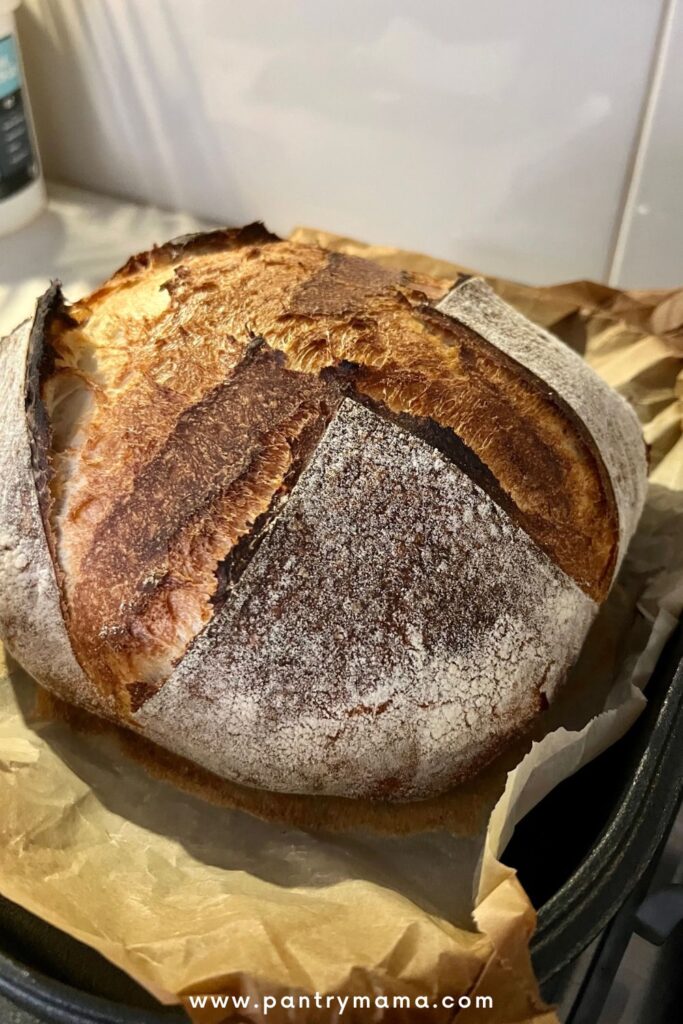
This long fermented sourdough bread recipe will give you an artisan sourdough bread rich in flavor with a crackly crust and open crumb. It's best suited to people who like a deeper level of sour flavor or require a lower level of gluten and phytic acid. If you really do like big flavors, you might also enjoy this hearty sourdough rye bread.
If you'd prefer a quicker recipe, you might like this same day sourdough bread recipe.
You can find my beginner sourdough resources here:
- Sourdough Glossary (50+ sourdough terms explained)
- How to Make a Sourdough Starter from Scratch
- Sourdough for Beginners (simple sourdough bread recipe)
- Bulk Fermentation Explained
What is the importance of a long fermentation in sourdough bread?
True sourdough bread is made using a sourdough starter that has been colonised with wild yeast and lactic acid bacteria. The wild yeast in your sourdough starter consume the sugars in the flour and rise your bread by producing CO2 that is trapped inside the gluten network. But, perhaps more importantly, the bacteria in your starter break down the gluten in your dough, making the resulting loaf much easier to digest, even if it's made with white bread flour.
The longer the dough ferments, the more digestible the sourdough bread becomes (and the stronger the sourdough flavor becomes too!).
In fact, a long fermented sourdough bread makes the nutrients much more available to your body. It produces a lower surge in blood sugar, which means that it is a lower glycemic index food.
This is so much better for you than regular bread which can cause big spikes in blood sugar, rather than prolonged energy release.
This makes long fermented sourdough bread much better for you!
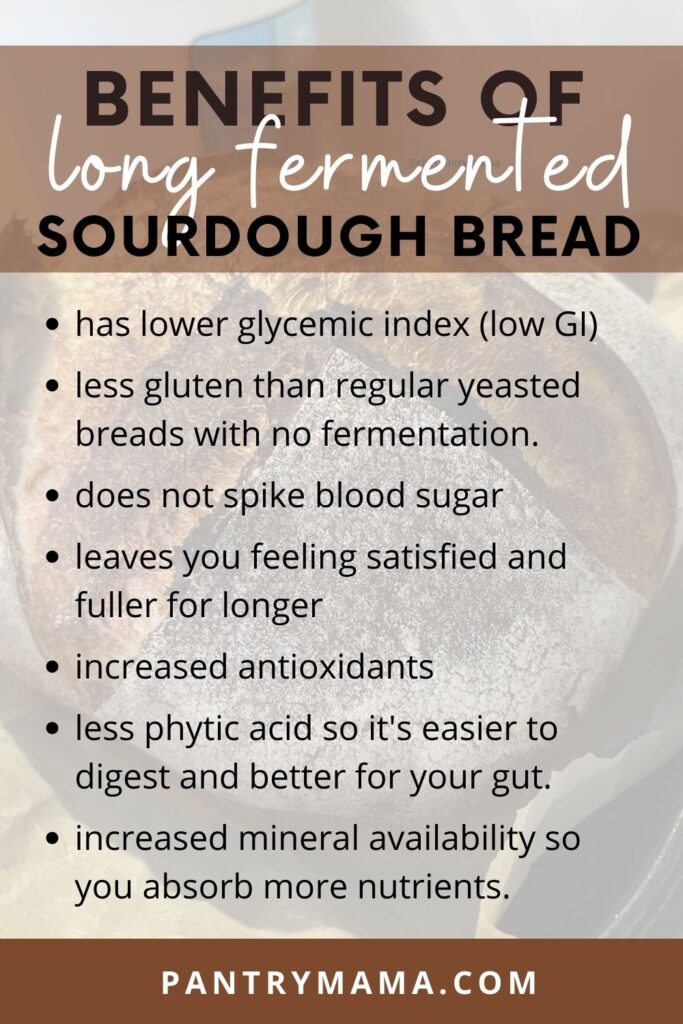
How to make Long Fermented Sourdough Bread (step by step guide)
You can use white bread flour or whole wheat flour for this recipe. You will get the best results from using straight bread flour, but blending up to 50% whole wheat can give you a good complexity of flavor too. I don't recommend using all purpose flour for this recipe.
This is not a high hydration dough and should be fairly easy to handle at around 70% hydration.
I've outlined the process of making a long fermented artisan sourdough bread in a step by step guide (you'll also find the process written into the recipe card at the end of this blog).
I have based this long fermented sourdough recipe on my original recipe for simple sourdough bread.
DAY 1
Step 1 - Feed Your Starter
Get your sourdough starter ready by taking 50g of starter and feeding it with 50g of flour and 50g of water. You'll use this in your dough once it's at its peak.
An active sourdough starter will give you the best fermentation! Remember to use a rubber band so you can see when your starter is at its peak. You can read more about the best time to use sourdough starter here.
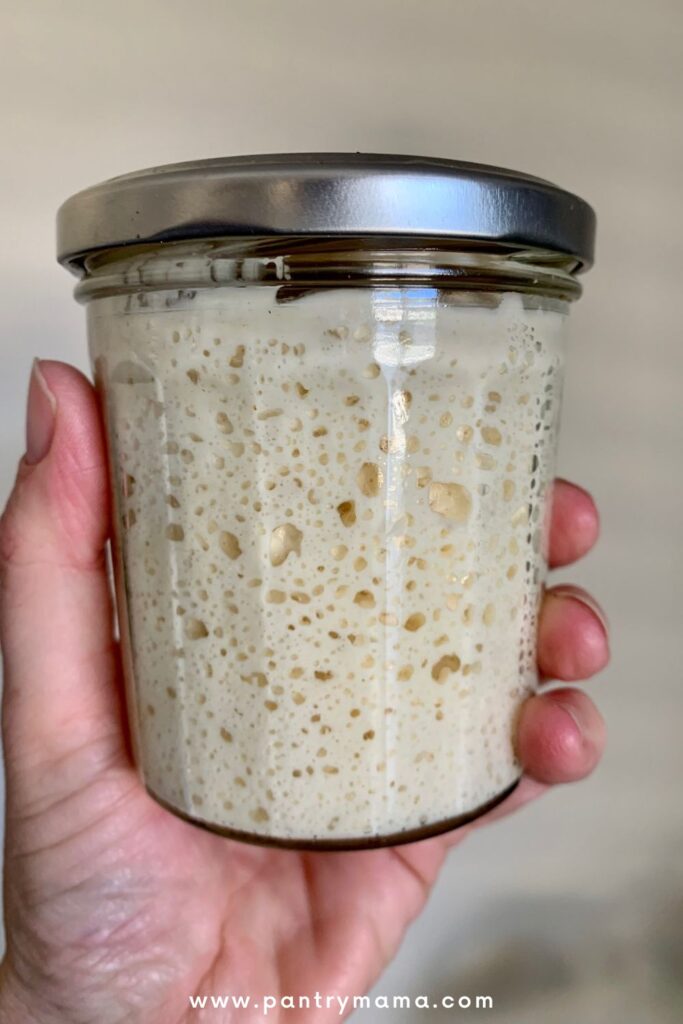
Step 2 - Autolyse
Weigh out your sourdough starter and water into a large ceramic or glass bowl.
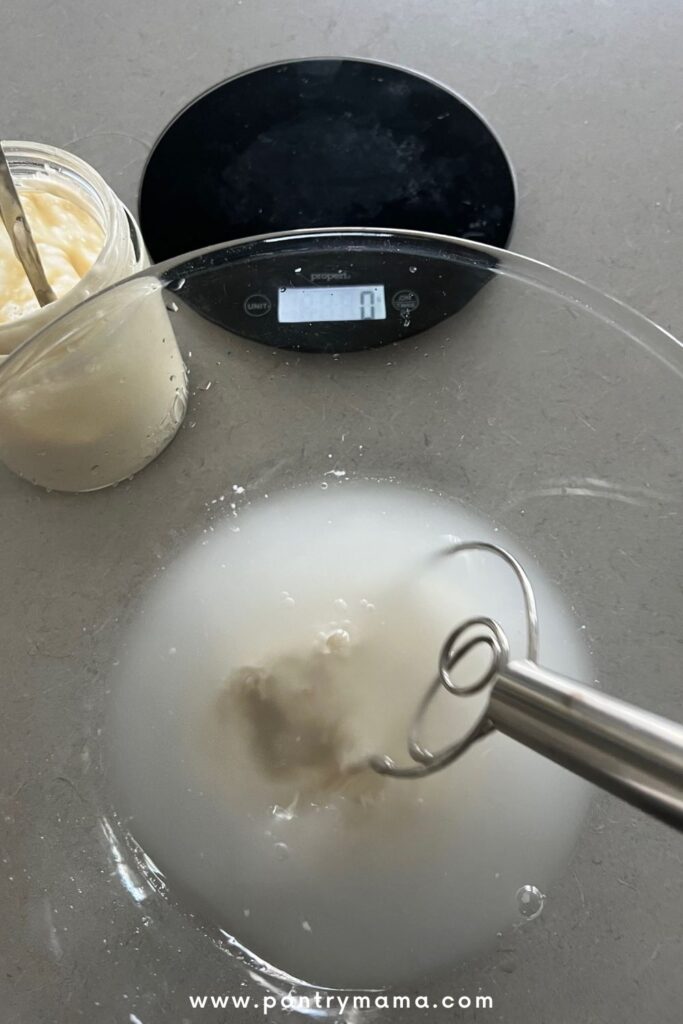
Mix the water and starter together briefly. Then add your flour and salt and mix whole lot together to form a shaggy dough.
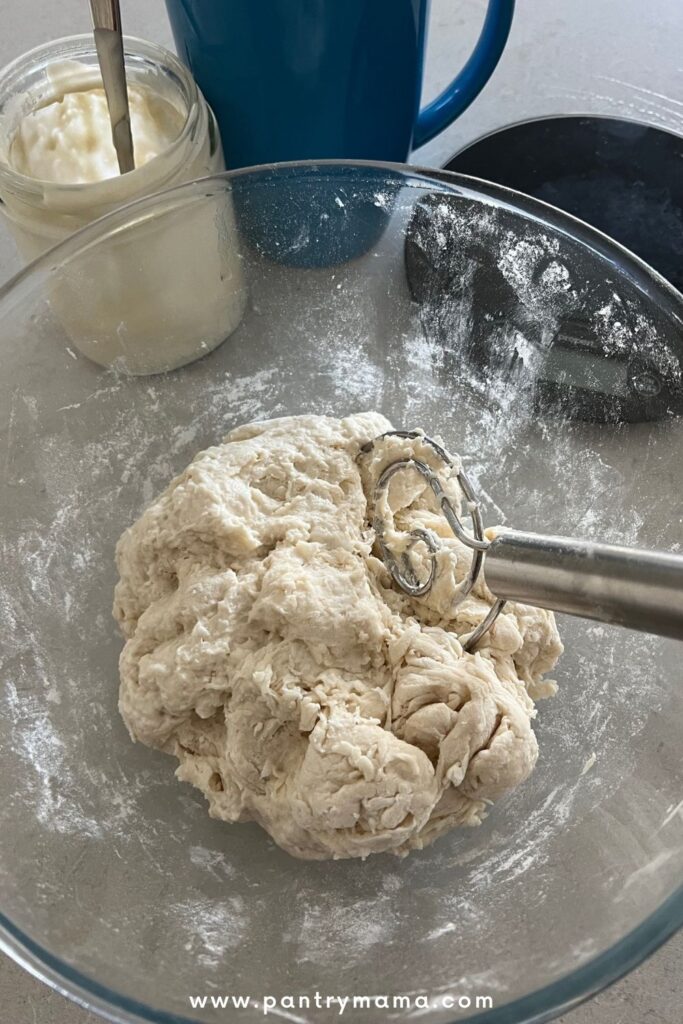
Cover your bowl with cling film or a damp tea towel and let it sit for around 1 hour. It's ok if it's a little bit longer, it's not going to matter too much.
I find a dough scraper the easiest way to mix it as you can keep the sides of bowl clean. The dough will be fairly shaggy and only just brought together.
You might wonder how this will turn into bread, but just wait, time is your friend and the dough will change in around an hour. This process is called the "autolyse" and allows your flour to soak in all the water and become hydrated.
Step 3 - Forming Up The Dough
After the dough has been through autolyse you need to bring it together into a ball. Work your way around the bowl, grabbing the dough from the outside, stretching it up and over itself, into the centre, until a smooth ball is formed. You shouldn't need more than about 20-30 stretches to form the ball.
Once the dough has formed into a smooth ball, pop the cling film back on and let it rest for 30 minutes.
You'll notice that the dough is fully hydrated after soaking all the water up. It will be fairly sticky but as you bring it into a ball, it will become smoother and shinier.
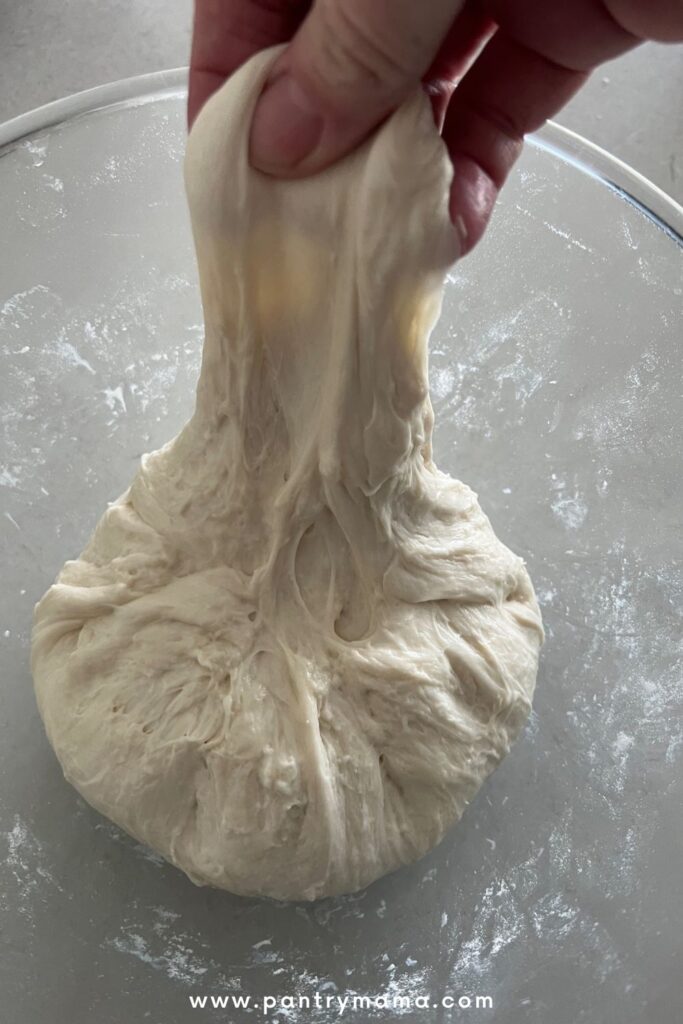
Step 4 - Stretch & Fold
- Over the next few hours you need to create some structure for your dough by "stretching and folding".
- Aim to do around 4-6 sets of stretches and folds.
- For each set, stretch the dough up and over itself 4 times. Leave around 15 minutes in between each set. Again you do not have to be exact with time, but you need to do at least 4 sets over 2 hours.
Step 5 - Bulk Ferment (Dough Rise)
Once you've finished your stretch and folds, place the cling film or damp tea towel back over your dough and let it rest and ferment (a plastic cover is a better option for this stage).
You want to allow your dough to rise until it's JUST UNDER DOUBLE. This dough has a low percentage of sourdough starter and is suitable for an overnight fermentation.

DAY 2
Step 6 - Shaping
Once your dough has finished its first ferment, it's time to shape it into either a boule or a batard.
You'll need to flour your counter top with rice flour for this (we use rice flour because it has no gluten). Try to be quite sparing with the rice flour, you only need a very light dusting.
Use a silicone dough scraper to gently ease the dough out of the bowl. You want it to land upside down on your counter so that the smooth top of the dough is on the countertop and the sticky underside is facing up. This will make it easier to shape.
You want to pull the edges of the dough into the centre and then flip it over so that the sticky side is now underneath. Using the stickiness, gently pull the dough into a tight ball.
You will need a banneton to put your dough into. If you do not have a banneton, then a bowl or basket lined with a floured tea towel is perfectly fine. Make sure your bowl isn't too big though, you want your dough to retain some shape.
Whatever you're using needs to be liberally floured with your rice flour. If you're using a banneton - liberally sprinkle it with rice flour. If you're using a cloth or tea towel, rub the flour into it to ensure it becomes non stick. A floured proofing basket is key to non stick sourdough!

You can use this video to see how I've shaped the dough into a boule.
Step 7 - Placing into a Banneton
Once the dough is shaped into a tight ball, place it into your banneton smooth side down, so your seam is on the top - this way the top of your dough will get the pretty lines from the banneton.
If you're using a cloth or tea towel in a bowl it's ok to put your dough with the smooth side up. Just make sure the dough is tight.
Lift your dough around the edges to pop a little more rice flour if you feel it needs it. Just try to handle the dough as little as possible and be really gentle as you really want to preserve all the gases and air bubbles that have formed during your bulk ferment.
Step 8 - Cold Ferment (The Key to Long Fermentation)
Now the dough is in its "shaping container" cover it loosely with a plastic bag or damp tea towel and place into the fridge. You will need to leave your shaped dough in the fridge between 24 to 48 hours (or anywhere in between). It's super important that your fridge is set to the correct temperature for this (3C or colder)!
I use a large plastic bag to cover it - I just reuse it each time. This period of cold fermentation is the KEY to long fermented sourdough bread!
Step 9 - Preparing to Bake
Once you're ready to bake your sourdough, you'll need to preheat your oven to 230C/450F.
Place your Cast Iron Dutch Oven into the oven when you turn it on so it gets HOT. Try to preheat for around 1 hour to ensure your oven is super hot - but you know your oven so just adjust this time if you need to.
Leave your dough in the fridge until the very last minute - placing a cold dough into a hot oven will give you a great "spring".
Step 10 - Bake Time!
Now it's time to bake!
When your oven is at temperature, take your sourdough out of the fridge. Gently place it onto a piece of parchment or baking paper.
Make sure that you make the parchment paper big enough to use the edges as a handle to lower to dough into your Dutch Oven.
Gently score your bread with a lame, clean razor blade or knife. At minimum a large cross is sufficient, but you can get as artistic as you like. You can find my full guide on how to score sourdough bread here.
Carefully take your dutch oven out of the oven. Place the sourdough into the pot using the baking paper as a handle. Put the lid on and place into the hot oven.
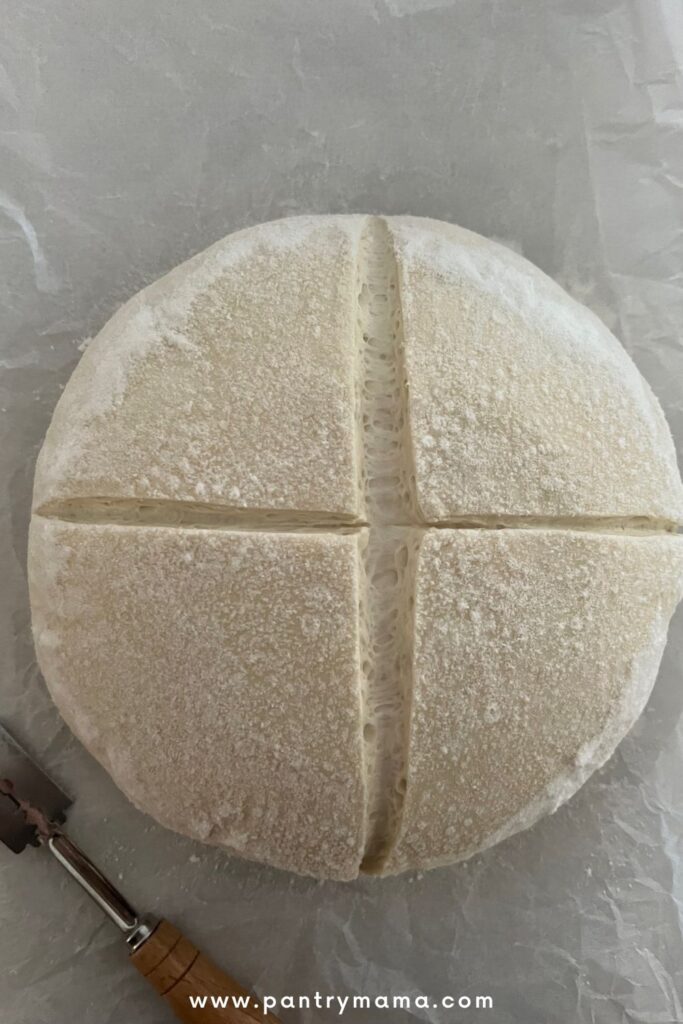
BAKE TIME:
30 Minutes with the lid on at 230C/450F plus
10-15 Minutes with the lid off at 210C/410F
Step 11 - Finishing The Bake
When you remove your dough from the oven, carefully remove it from the dutch oven as soon as possible and place on a wire rack to cool.
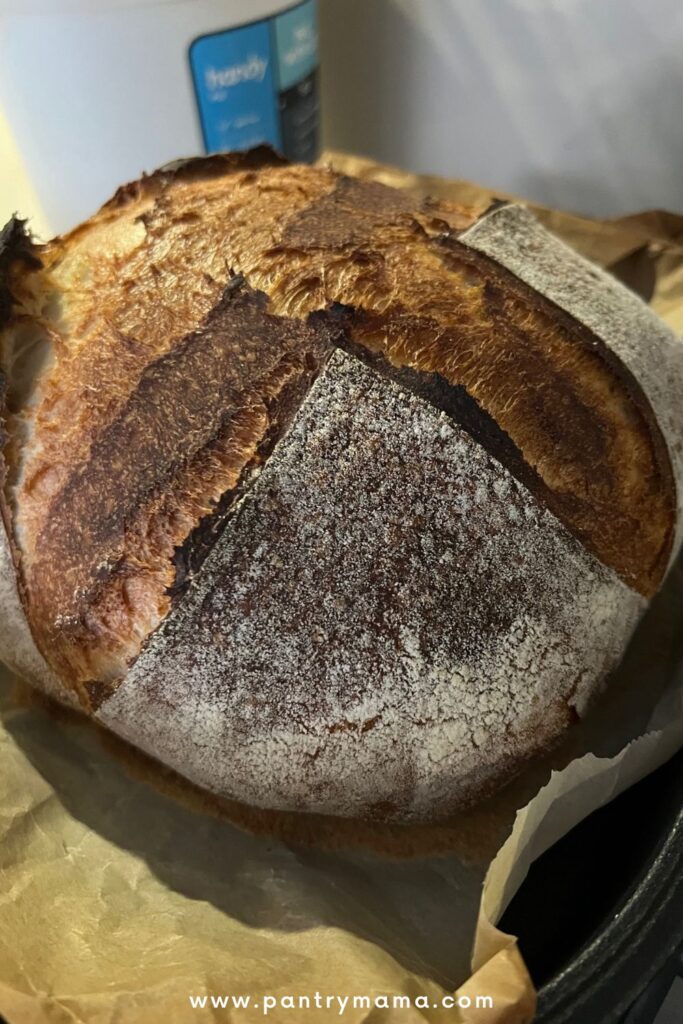
Why is temperature so important in long fermented sourdough bread?
Temperature is so important to sourdough bread and the fermentation process because it will determine how long the bulk fermentation and cold fermentation last. Bulk fermentation is always done at room temperature and it is this part of the process that allows the yeast to rise your sourdough bread. The temperature of your kitchen, along with the amount of sourdough starter, will determine the length of bulk fermentation.
Similarly, the temperature of your fridge will determine a successful cold fermentation. The cold fermentation should be conducted at temperatures at 3C or lower. If your fridge is warmer than this, your shaped sourdough will over ferment too quickly to reap the benefits of an extended fermentation period.
Lower temperatures, along with a lower percentage of sourdough starter will enable you to ferment your sourdough for a longer period of time, maximising the health benefits. The trick with long fermented sourdough is to balance the break down of gluten which occurs during the cold retard with the desired oven spring. It can be a difficult thing to achieve.
You can read more about the differences between bulk fermentation and cold fermentation here.
Baker's Timeline for Longer Fermentation
The great thing about long fermentation is that you can make it work for you. Most of the time invested into this recipe is hands off. The dough will spend more time in the fridge than it will in your hands! Pretty cool, right? All those good bacteria do the hard work for you!
This timeline is an example only and you can change it to suit your needs. This one has the process starting on a Wednesday and finishing on a Saturday morning - giving you delicious freshly baked sourdough for the weekend!
DAY 1 (Wednesday)
2pm Feed sourdough starter
7pm Stretch and Fold
9pm Bulk Fermentation overnight (make sure temp is below 21C)
DAY 2 (Thursday)
6am Shape the dough and place into the banneton then into the fridge for cold fermentation.
DAY 3 (Friday)
Just leave your sourdough in the fridge - try to place it at the back of the fridge where it's coldest. It will be in there for 48 hours.
DAY 4 (Saturday)
6am Preheat the Oven
7am Bake your sourdough bread!
You can learn more about sourdough baking timelines here.
Can Sourdough Ferment Too Long?
Yes sourdough can be left to ferment too long. If you leave your dough to ferment for too long during bulk fermentation you will end up with soupy dough that cannot be shaped into a nice boule or batard. There is a limit to bulk fermentation, however it can be manipulated by adjusting the amount of sourdough starter you use and or the temperature of your kitchen.
Sourdough can also be fermented too long during cold fermentation because if you leave it in the fridge for extended periods you risk the lactic acid bacteria breaking down the gluten structure to a point where it can no longer contain the CO2 produced by the yeast. This is result in a loaf that collapses when you tip it out of the banneton.
The trick to long fermented sourdough is to balance the desired flavor with the gluten structure. This can be difference between good bread and great bread!
How Long Should You Ferment Sourdough Bread?
This really is a tricky question because fermentation time depends on your sourdough starter strength and age, the amount of it you use and how warm your environment is.
Typically, bulk fermentation will take between 6 to 8 hours, but could be longer or shorter by manipulating starter amount and temperature.
Ideally, you don't want to allow sourdough bread to cold ferment for longer than 72 hours. Even up to 48 hours, you do risk some loss of gluten structure unless you manipulate the amount of starter down.
Frequently Asked Questions
You can add 20g of olive oil to this dough, however I don't think that you need to. As long as your sourdough starter is mature and you judge fermentation accurately, you should end up with a light, crispy crust on this loaf.
Sourdough yeast survives in acidic conditions, however the acids produced by the lactic acid bacteria will eventually break down the gluten network which releases the CO2 and results in a flat sourdough bread.
Wild yeast are resistant to the acids produced by the sourdough starter and are able to live in a symbiotic relationship with the bacteria.
No sourdough bread made with wheat flour, whether it's been fermented for a long time or not, will still contain gluten, even if it's a lower amount. Long fermented sourdough bread may be tolerated by those sensitive to gluten but will still be unsuitable for celiacs unless it has been made using gluten free flour. You can read more about this topic here.
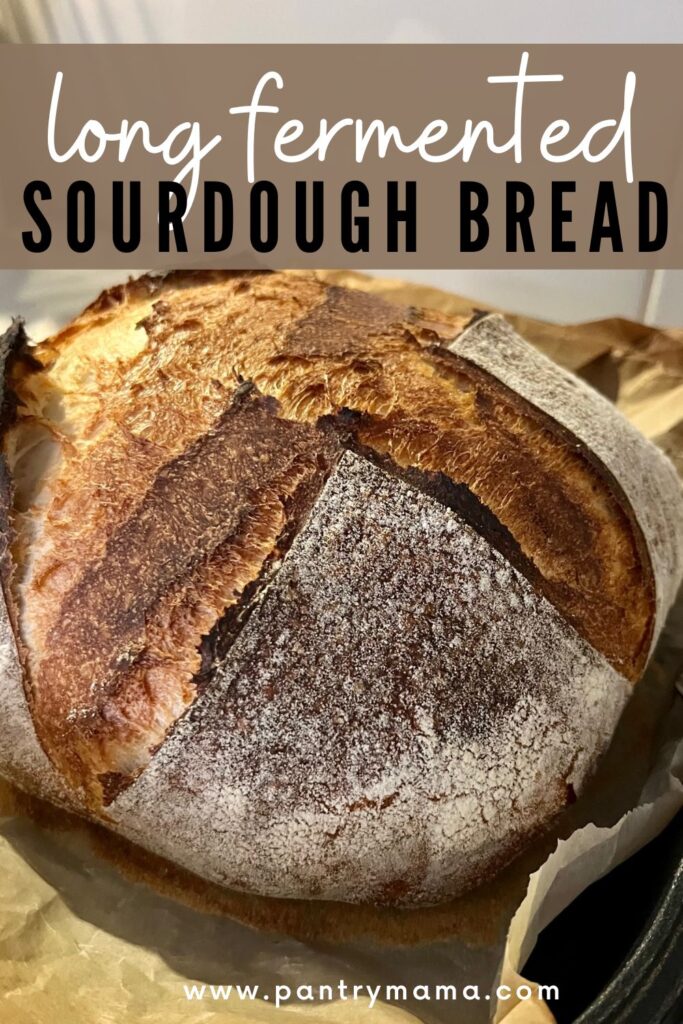
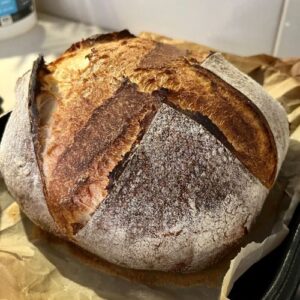
Long Fermented Sourdough Bread Recipe
Equipment
- Mixing Bowl
- Digital Scales
- Banneton
- Dutch Oven
Ingredients
- 500 g Bread Flour
- 350 g Water
- 20 g Sourdough Starter can increase if particularly cold/winter months
- 10 g Salt
Instructions
- Autolyse - Premixing The DoughWeigh out your sourdough starter and water into a large ceramic or glass bowl. Glass is always good as you can see what's happening underneath your dough. This recipe is based on you having an active, mature sourdough starter that you have fed a few hours before starting your bake.Mix the water and starter together briefly. Then add your flour and salt and mix whole lot together to form a shaggy dough. I find a dough scraper the easiest way to mix it as you can keep the sides of bowl clean.The dough will be fairly shaggy and only just brought together (see photo). You might wonder how this will turn into bread, but just wait, time is your friend and the dough will change in around an hour.
- Cover your bowl with cling film or a damp tea towel and let it sit for around 1 hour. It's ok if it's a little bit longer, it's not going to matter too much.This process is called the "autolyse" and allows your flour to soak in all the water and become hydrated. You can see how the dough has changed in this photo.
- Forming Up The DoughAfter the dough has been through autolyse you need to bring it together into a ball. Work your way around the bowl, grabbing the dough from the outside, stretching it up and over itself, into the centre, until a smooth ball is formed. You shouldn't need more than about 20-30 stretches to form the ball. You'll notice that the dough is fully hydrated after soaking all the water up. It will be fairly sticky but as you bring it into a ball, it will become smoother and shinier.
- Once the dough has formed into a smooth ball, pop the cling film back on and let it rest for 30 minutes.
- Stretch & Fold - Creating StructureOver the next few hours you need to create some structure for your dough by "stretching and folding". Aim to do around 4-6 sets of stretches and folds. For each set, stretch the dough up and over itself 4 times. Leave around 15 minutes in between each set. Again you do not have to be exact with time, but you need to do at least 4 sets over 2 hours.
- Bulk FermentOnce you've finished your stretch and folds, place the cling film or damp tea towel back over your dough and let it rest and ferment (a plastic cover is a better option for this stage). You want to allow your dough to rise until it's JUST UNDER DOUBLE.See notes below for more info on this step.
- Shaping The DoughOnce your dough has finished it's first ferment, it's time to shape it into either a boule or a batard. You'll need to flour your counter top with rice flour for this (we use rice flour because it has no gluten). Try to be quite sparing with the rice flour, you only need a very light dusting.Use a silicone dough scraper to gently ease the dough out of the bowl. You want it to land upside down on your counter so that the smooth top of the dough is on the countertop and the sticky underside is facing up. This will make it easier to shape.You want to pull the edges of the dough into the centre and then flip it over so that the sticky side is now underneath. Using the stickiness, gently pull the dough into a tight ball.You will need a banneton to put your dough into. If you do not have a banneton, then a bowl or basket lined with a floured tea towel is perfectly fine. Make sure your bowl isn't too big though, you want your dough to retain some shape.Whatever you're using needs to be liberally floured with your rice flour. If you're using a banneton - liberally sprinkle it with rice flour. If you're using a cloth or tea towel, rub the flour into it to ensure it becomes non stick.
- Placing Into A BannetonOnce the dough is shaped into a tight ball, place it into your banneton smooth side down, so your seam is on the top - this way the top of your dough will get the pretty lines from the banneton. If you're using a cloth or tea towel in a bowl it's ok to put your dough with the smooth side up. Just make sure the dough is tight.Lift your dough around the edges to pop a little more rice flour if you feel it needs it. Just try to handle the dough as little as possible and be really gentle as you really want to preserve all the gases and air bubbles that have formed during your bulk ferment.
- Cold FermentNow the dough is in its "shaping container" cover it loosely with a plastic bag or damp tea towel and place into the fridge. You will need to leave your shaped dough in the fridge between 24 to 48 hours (or anywhere in between). It's super important that your fridge is set to the correct temperature for this!I use a large plastic bag to cover it - I just reuse it each time. This period of cold fermentation is the KEY to long fermented sourdough bread!
- Preparing To BakeOnce you're ready to bake your sourdough, you'll need to preheat your oven to 230C/450F. Place your Dutch Oven into the oven when you turn it on so it gets HOT. Try to preheat for around 1 hour to ensure your oven is super hot - but you know your oven so just adjust this time if you need to.Leave your dough in the fridge until the very last minute - placing a cold dough into a hot oven will give you a great "spring".
- Bake Time!Now it's time to bake!When your oven is at temperature, take your sourdough out of the fridge. Gently place it onto a piece of baking paper. Make sure that you make the baking paper big enough to use the edges as a handle to lower to dough into your Dutch Oven.Gently score your bread with a lame, clean razor blade or knife. At minimum a large cross is sufficient, but you can get as artistic as you like. You can find my full guide on how to score sourdough bread here.Carefully take your dutch oven out of the oven. Place the sourdough into the pot using the baking paper as a handle. Put the lid on and place into the hot oven. If you want to you can spritz your dough with extra water before you put the lid on.BAKE TIME:30 Minutes with the lid on at 230C/450F plus10-15 Minutes with the lid off at 210C/410F
- Finishing The BakeWhen you remove your dough from the oven, carefully remove it from the dutch oven as soon as possible and place on a wire rack to cool.
Notes
- Notes on Flour: This recipe is written using strong Bread Flour. Bread flour has a higher protein content than All Purpose flour. You can read more about the differences between All Purpose Flour and Bread Flour here.
- Notes on Sourdough Starter: This recipe is based on you having an active starter that you have fed a few hours before starting your bake. For info on how to make a sourdough starter, go here.
- Notes on Stretch & Folds: If you are going to do the stretch & folds on your bench top, spray your surface with water mist rather than using flour. You can leave the dough in the bowl if you want to. Wet your hands to stop the dough sticking - although it shouldn't be too sticky. It will get less sticky as you do your stretches and folds. For more information on how to do stretch and folds, go here.
- Notes on Bulk Fermentation: If your home is warm then your dough will ferment a lot faster and could be done in as little as a few hours. If it's colder, it will take longer.
I would recommend that you try to do your first few bulk ferments during daylight hours so that you can watch your dough closely.
Once you're more familiar with the process - and the temperature of your home - you will be able to do overnight ferments. You will know your dough is ready to move to the next stage when it is just under double in size. It will be fairly wobbly and full of bubbles. You should be able to see large air bubbles under the surface of the dough.
You don't want to let it go any further than doubled as it will be over fermented, particularly because you are doing a long cold ferment. You'll find more information on these topics here:
When is my bulk ferment finished? What is the difference between cold ferment and bulk ferment? Why does the amount of starter matter?
- Notes on Baking: If you're worried about the base of your bread burning, place a baking sheet on shelf underneath your Dutch Oven - it works! If you're worried about your bread not being cooked all the way through, turn the oven off and place your dough straight onto the oven rack. Leave the door ajar and let your bread rest there for a few hours. Make sure you don't close the door or your sourdough will sweat and you'll get a wrinkly, soggy crust. Remember not to cut into your loaf too soon - you'll need to let it cool for at least a few hours (4-6 is best).
Nutrition



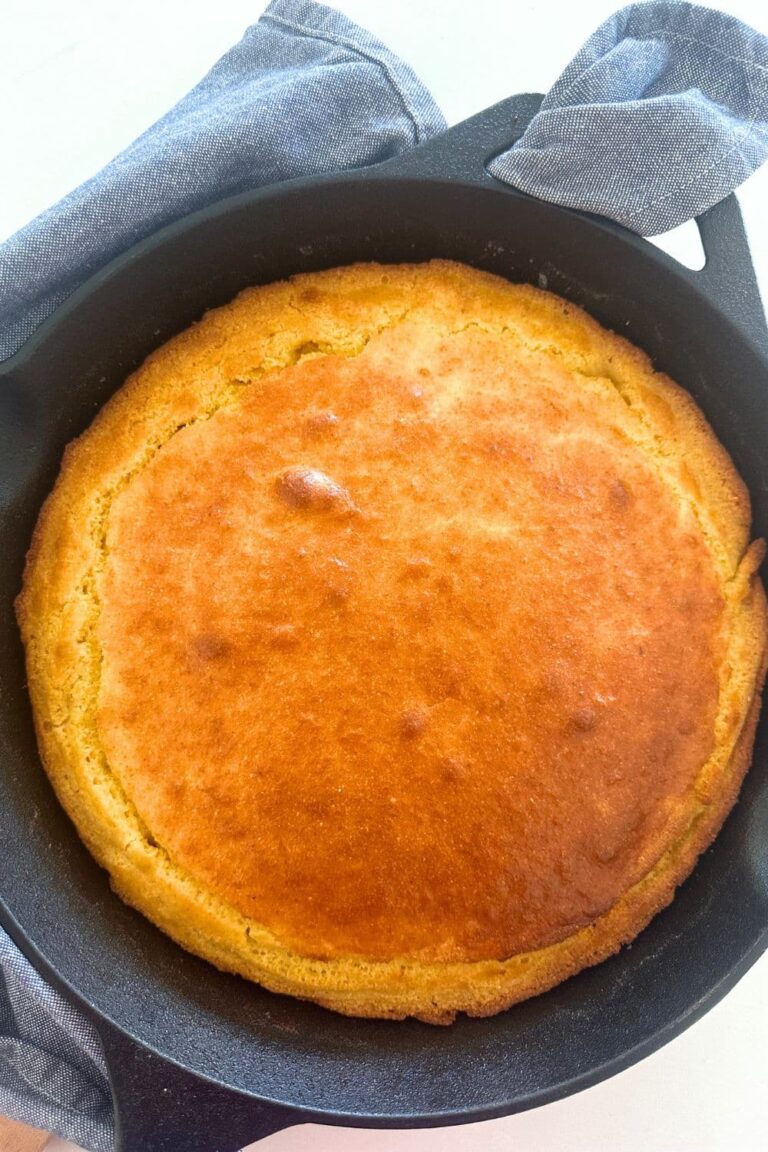
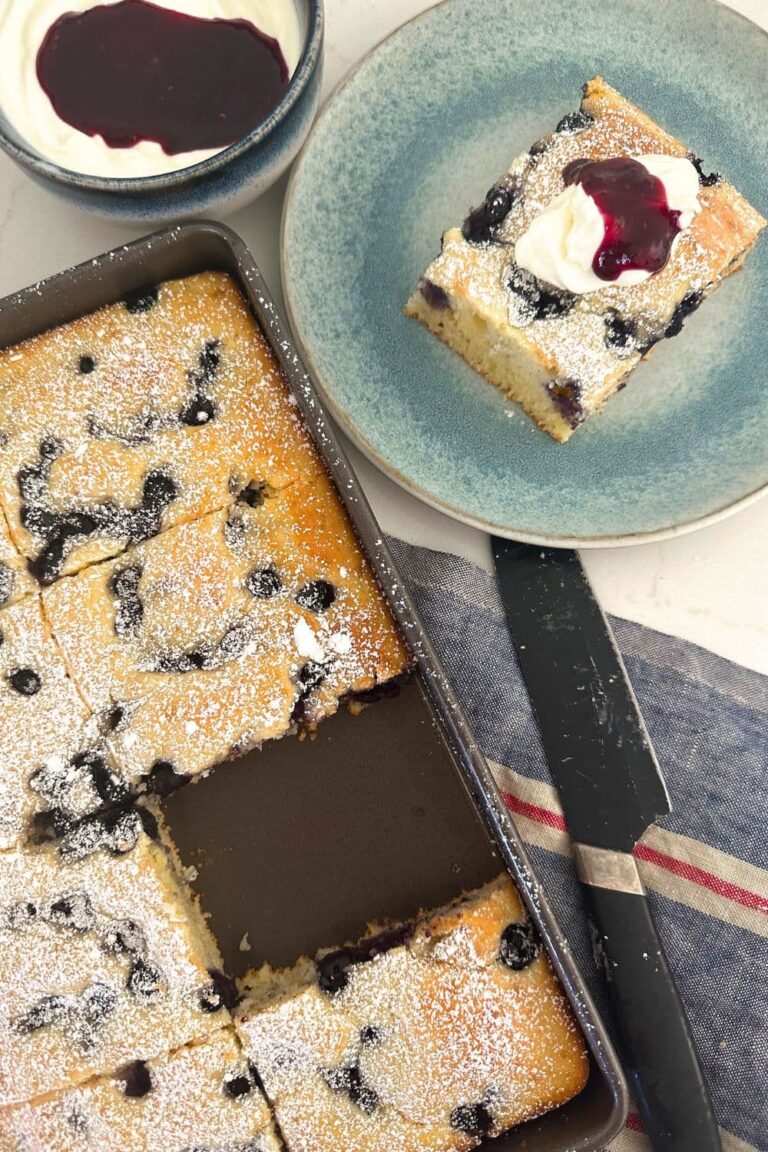
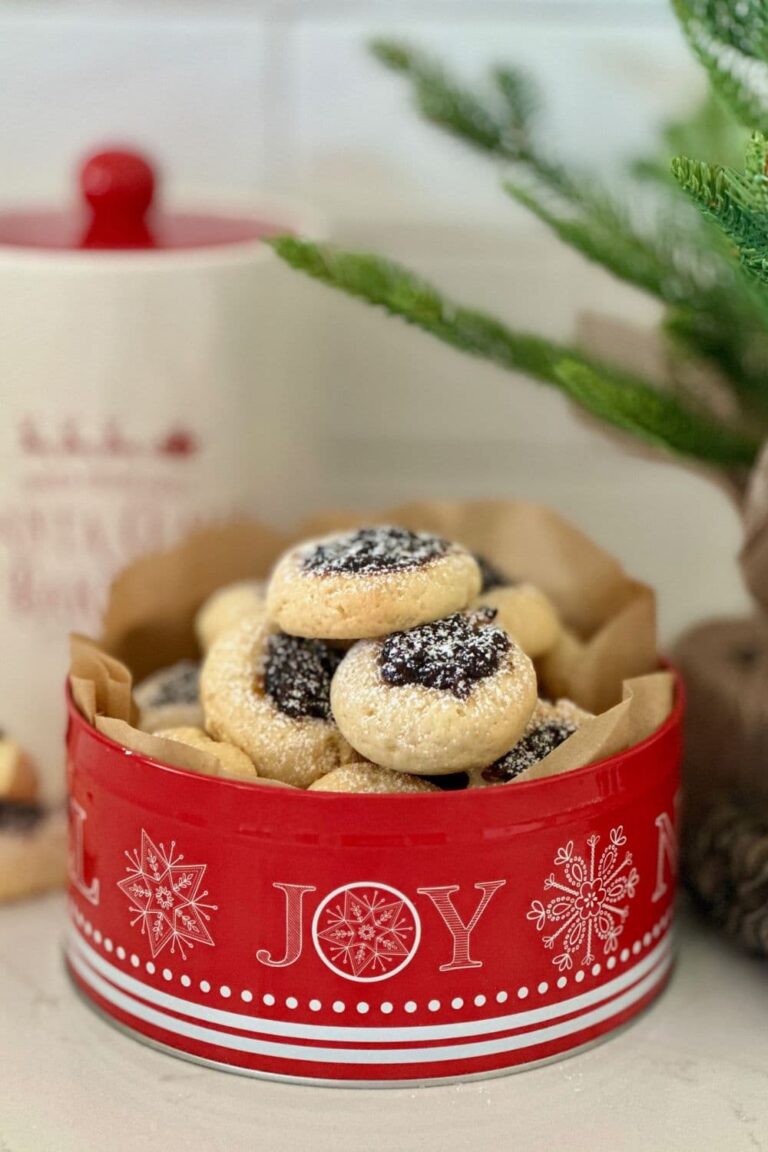
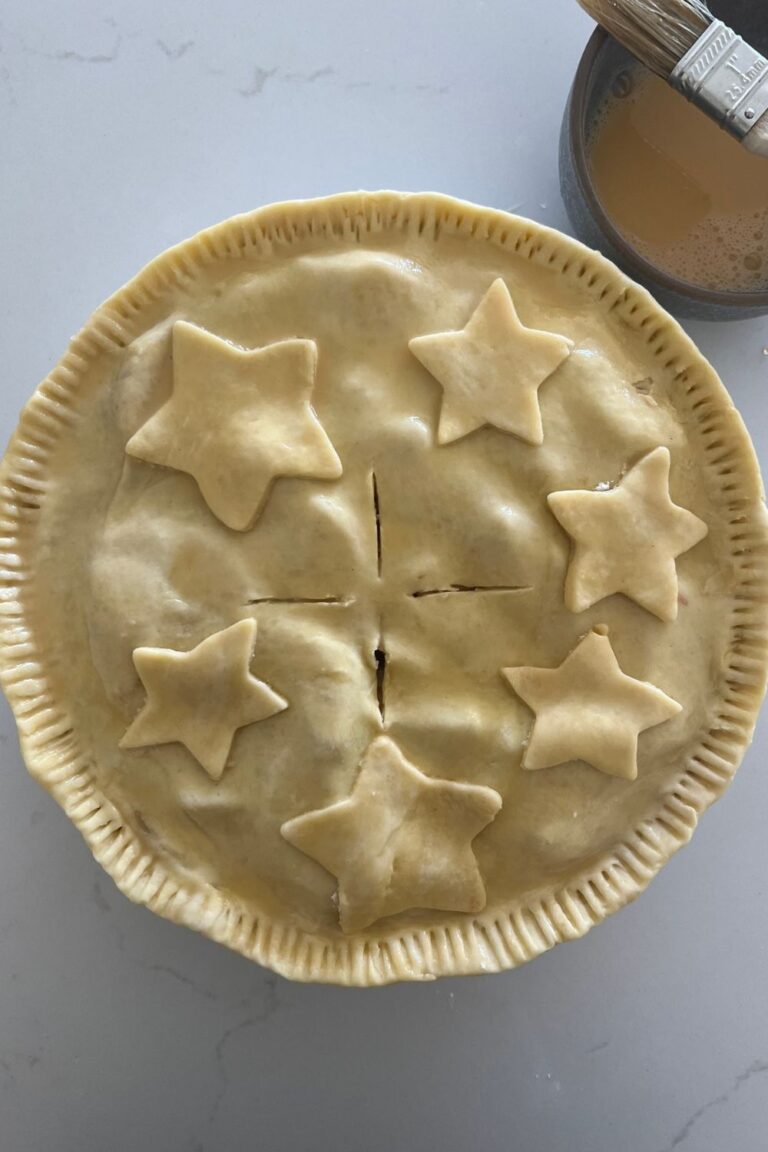

I’ve tried probably 7-8 recipes and this is going to be my go-to!! It was amazing. I used Red Mill Artesian bread flour and baked it as a cold bake with 4 ic cubes in my Staub Dutch oven. My loaf was the right amount of chewy, crust was crunchy but not too crunchy. Absolutely perfect!! Thanks so much!!
Hi,
I have a 5-quart regular (not enameled) Dutch oven, will it work for that recipe?
Thanks
I don’t often (or ever) leave reviews anywhere. But I felt the need to here! And I want to thank you so so much for all that I learned about sourdough from you. I have been playing with it for a while and made some good and some bad loaves… never really finding something that worked for me. I live in Mexico so the climate here is different. I recently started selling my sourdough bread and I wanted to really dial it in…. After reading everything on your website about sourdough I came up with a plan and routine that works amazing for where I live! I wish I could show you these loaves! They are the best I have ever made! I combined your quick recipe with long ferment method and it’s just perfect for baking here in Mexico! Thank you so so much! Of all the countless hours of reading I’ve done about sourdough over the years this site has been the best most useful I’ve come across. Happy baking!
Will adding viral wheat gluten to all purpose flour be ok?
Hi!
I’ve been making your sourdough for about a month now, but yesterday I forgot to put my dough into the fridge for the cold ferment. It’s been in bulk ferment now for about 24 hours. Is it definitely over fermented? Should I toss and start over?
Can this recipe be used for einkorn flour?
Can I use my mixer instead of fold method?
Wish you had a photo after step 2 is completed and before the dough is formed in step 3.
I have another question/comment. If you are NOT using a cast iron dutch oven with lid, then there is no need to preheat to 450 F? You've said later on in the recipe that without a lid, to bake at 410 F. I can only dream of a cast iron dutch oven, they are wildly expensive!
Love this recipe! My husband cannot tolerate traditional gluten breads but has no issues with this recipe. Can I use it to make buns? Shape them into buns before the bulk ferment? Thanks!
So glad you love it 🙂 Absolutely you can make buns 🙂
I absolutley love your slow fermentation recipe and all of your other recipes. But...say you don't have time to wait more than 2 hours for the 1st bulk fermentation b4 refrideration and it doesn't look jiggly or bubbly. What can I do after I have it in the fridge overnight to bring it back to life or should I just keep it there for longer than 48 hours?
If my starter was in the fridge, should I take it out in the morning before feeding it at 2pm?
Very excited to try this. Can the shaped dough be left at room temperature for 24hrs instead of in the fridge for 48hrs?
Love this recipe but I cannot seem to get the dough to come together. I follow the recipe to a "T" and still end up with soupy dough after the overnight ferment (in my pantry at 65 degrees F). Any suggestions?
I don't understand how to get the dough into the banneton without collapsing the bubbles, and also get the risen dough, ready for baking, out of the banneton, without collapsing the bubbles. I'm using your recipe, but I keep having this problem. Should I just rise the bread in the baking container? I love your directions website and all the directions and videos. Thank you!
I’m new here. I did everything well except forgot to tightly form my dough before putting it into the refrigerator for the long ferment. I just folded into a loose ball. It’s now in there covered in rice flour. Should I take it out and reshape it? What will happen if I don’t?
Thank you,
Kt
Not sure where I went wrong but after a shaped the bagels and let them get puffy they completely deflated as I was taking them off the pan. They looked so good. Help please!
Yum! Thanks! One of my best loaves yet and I was surprised at how mild the flavor was. It seemed to be overproofed because I apparently turned my back on it before I put it in the fridge. Is this the wrong way to see how it doubled: I added up the grams and doubled that number, and tried to eyeball it to a bit under 2.8qt in the 6qt cambro I had it rising in. Because it's more of a ball when you first put it in. Maybe when I do single loaves I have to use a smaller container? 🙂
I make this bread weekly and have been doing so for a few months. I sought it out because I am watching my blood sugar and long fermented sourdough is supposed to help. I’m not a doctor but my blood sugar does not go up more than 30 points when I eat a slice of this bread with breakfast. I digress.
I would not change a thing with this recipe. Timing changes with the seasons and house temperature so I have to adjust but still, this makes a beautiful, delicious loaf. It stores in a zip lock once cooled, at room temp for a few days and then I throw it in fridge and use it for toast. If there is still some bread around when I bake my next loaf, I cube it, add olive oil and spices and make croutons. This bread is so easy and delicious I will make it forever! Thank you!
Do you ever sell the made bread?
The ingredients are the key to making a good sourdough. I use bottled spring water and King Arthur Bread flour 12.7 percent. This is the most thorough and best recipe I’ve come across. I have been baking this recipe about 2 years now every week. My husband has to have it with his breakfast every morning. I like to keep it in the fridge for 48 hours to get the sour taste. I also drop a couple ice cubes in right before I put it in the oven.
All my grandkids crave it and some ask for a whole loaf on their birthdays. Thank you Pantrymama 🥖
Thank you, Nancy! We love to hear that!
This recipe was easy to follow and I got the best results ever my first time!! The bread improved in texture and flavor after a couple of days! I am so excited over this and will make it again a few times before I move on to a different recipe!
My GO TO sourdough bread recipe. I have a gluten sensitivity and this bread don't hurt my tummy yay!!! SOOOO YUMMY !!!!!
I did want to ask the author if she has a 50/50 recipe (whole wheat/bread flour) long fermentation recipe I can follow?? Please let me know 🙂
I'm so glad you love this recipe! You could try this whole wheat rye sourdough bread or this whole wheat sourdough bread 🙂
Why only 20 g sourdough starter for long ferment compared to 150 for short ferment?
Because you use a small amount of starter for a long ferment ... lower ratio equals long ferment, higher amount of starter equals faster ferment. So if you want a long ferment, use 20g and if you want a fast ferment, use 200g 🙂
JW--in the recipe you call for 20g starter -- is this correct? Just making sure as it seems low compared to the amount I have been using with similar flour salt and water measurements to yours. Thank you!
Yes this is correct, it's a long fermented recipe so the smaller amount of starter means a longer ferment time 🙂